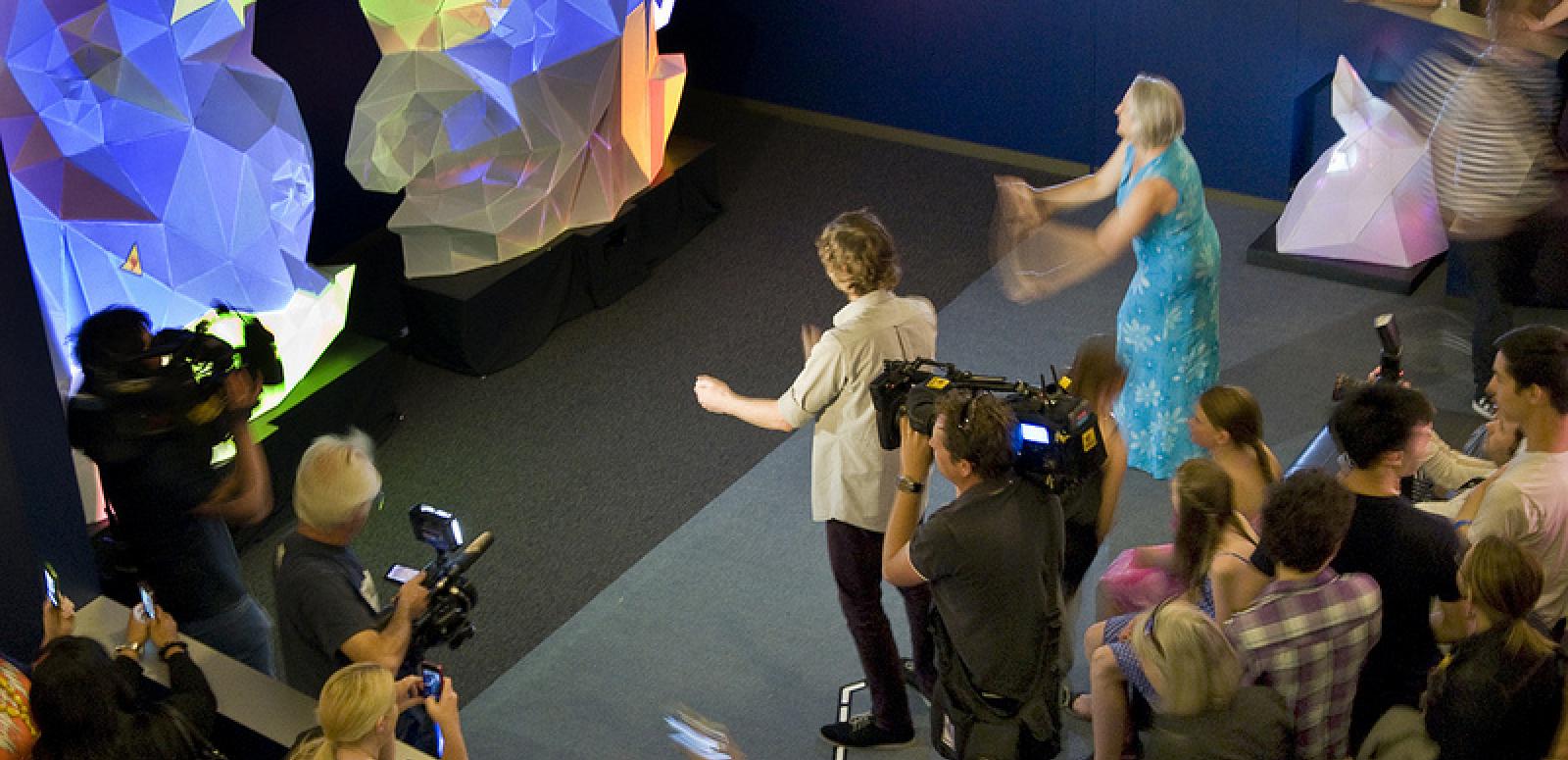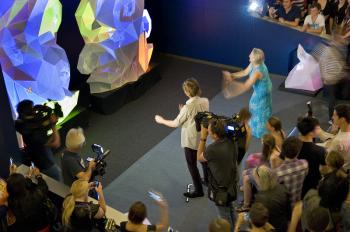

Fractured Heart

The Gotye-inspired, illuminart-produced Fractured Heart sound and light installation has captured the imagination of many: children and adults visiting the NFSA, and even our own staff who drop into the gallery on their lunch breaks for a little unwind and musical play on the Fractured Heart.
Scarlet Barnett and Janet Berenyi, from our Exhibitions team, share their experiences watching people interact with the sculpture.
I have spent a lot of time with the sculpture, talking to visitors and showing them how to interact with it. It is made from lycra and steel rods, and while visitors have described it as a teddy bear or an iceberg, it is very much a heart.
But what happens inside this ‘heart’? It is an impressive cooperation of technology, materials and creativity. An Xbox Kinect waits patiently at the foot of the sculpture until a visitor is ready to have a turn at playing it. The Kinect ‘registers’ – that is, it picks up – the location of the hands of the user and tracks their movements, sending this information to a computer. A combination of different software programs converts the movements into an animation, which it overlays on top of a set of graphics. The animation and graphics are then sent to a projector waiting silently to the side of the sculpture. The end result is an intricate design of shapes and colours projected onto the fractured surface of the heart and an animation of hand movements that simultaneously trigger sound bites taken from Gotye’s award-winning hit songs ‘Somebody That I Used to Know’ and ‘State of the Art’.
I enjoy the way it changes from its active to its resting state. When people are interacting with the sculpture, it provides a vivid light display with accompanying music, both directed by the person playing it. When the visitors leave, it returns to its quiet state with a soft blue light projected across the surface. The quiet heart creates a soothing, relaxed atmosphere, almost like that of an aquarium.
Scarlet Barnett
Gotye's Fractured Heart
I have been looking after the wonderful Fractured Heart since it was open to the public in December 2012. Today’s visitors were a typical cross-section of the people who have enjoyed the sculpture. We started the day with a group of schoolchildren, who arrived early so they’d be able to spend the extra time playing with Fractured Heart. They merged in with a group of English as a Second Language students from the Australian National University. All of them had a go playing the sculpture.
Gotye and Illuminart have given the NFSA permission for people to photograph and video their experience playing the sculpture, so the students took photos of each other in the coloured animations of the sculpture while their teacher videoed the session. Before coming to the NFSA the students had spent class time on our website learning about Gotye. They were intrigued with the Fractured Heart showcase displaying the notebooks and clay models used by the illuminart team to develop and construct the sculpture. They especially liked the photo of Gotye and Kimbra singing at the 2011 ARIA Awards.
Mid-morning we were visited by a group of children with disabilities and their carers. One boy was profoundly deaf, and his teacher used sign language to explain to him how Fractured Heart worked. He then spent 15 minutes playing the sculpture, his face lit up with pleasure as he got the sculpture to play, seeing the lights flash as he moved his hands. He was enchanted as he had had no previous experience with this type of motion-detection technology. Similarly, a vision-impaired child in her wheelchair was able to connect to the sculpture with the help of her carers. Even though she couldn’t see the colours, she could hear the sounds that she made with her movements.
Later we were visited by the South Australian Historical Society. This self-guided group of 32 adults spent two hours in the gallery space. They egged each other on to play Fractured Heart. They knew the song and liked the fact that the sculpture could be played at any pace depending on the skill and the mood of the player – slow or boppy. They also enjoyed the rest of the gallery, especially the silent footage from the early twentieth century and the Picnic at Hanging Rock costumes.
We finished the day with a couple from China. They let me know that they were very keen on getting Fractured Heart on display in China — somehow. While the woman spoke very little English, her husband said that ‘she loves to dance’. She spent ten minutes dancing in front of the sculpture, and although she looked at the rest of the gallery, she kept coming back to Fractured Heart. Her partner took lots of photos and then she had her turn at the camera as her husband did Tai Chi very gracefully in front of Fractured Heart. His slow and flowing movements seemed to bring out the gentle blue and purple lighting along with the flute and vocals. It was beautiful to watch and hear.
It was just another day in the NFSA Exhibition Gallery, interacting with smiling people enjoying Fractured Heart.
Janet Berenyi
The National Film and Sound Archive of Australia acknowledges Australia’s Aboriginal and Torres Strait Islander peoples as the Traditional Custodians of the land on which we work and live and gives respect to their Elders both past and present.